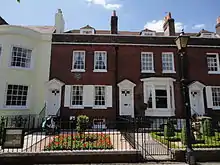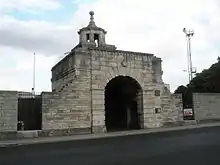Landport
Landport is a district located on Portsea Island and is considered the city-centre of modern-day Portsmouth, England. The district is centred around Commercial Road and encompasses the Guildhall, Civic Centre, Portsmouth and Southsea Station and Commercial Road central shopping area. The original historic old town of Portsmouth lies to the south of Landport and is now known as Old Portsmouth. The district of Portsea lies to the West; Somers Town and Southsea are to the south; Fratton lies to the East and the Kingston Crescent area to the north.
| Landport | |
|---|---|
 Commercial Road, Landport | |
| North East | |
| Unitary authority |
|
| Shire county | |
| Country | England |
| Sovereign state | United Kingdom |
| Post town | Portsmouth |


Toponymy
The area derives its land from Landport Gate.[1] The Landport Gate held its name as early as 1727, however the settlement, while formed earlier and at least partially known as "Halfway-Houses",[lower-alpha 1] took the designation of Landport (Town) from 1831.[2]
History
Landport as a settlement began in the late eighteenth century as an overspill from the confines of the Old Portsmouth defensive fortifications and commenced with a series of halfway homes on the road from Landport Gate to the village of Kingston.[1] Overspill developed outwards from this road, which was to become known as Commercial Road,[1] itself forming part of what was later to be designated the A3 road to London.[lower-alpha 2][1]
Governance
The district is administered by the unitary authority Portsmouth City Council. It lies predominately within Charles Dickens Ward which also encompasses Portsea district and a portion of Fratton. The Parliament constituency is Portsmouth South.
Geography
The district contains the main shopping area for Portsmouth. Before World War II the district was also a residential area, mainly catering for employees of the naval dockyard and their families. The district was heavily damaged by bombing during the war. After the war the decision was made that most of the remaining houses were substandard and the area was largely cleared. Some of the cleared area was used for the controversial Tricorn Centre.
Mile End
Mile End began as a small 18th century settlement built on the London to Portsmouth A3 road, a mile to the north of the main Landport Gate entrance to the original walled town of Portsmouth (now Old Portsmouth).[3] Mile End was consumed within the rapid urban development of the Landport and Buckland areas during the 19th and 20th centuries. Much like neighbouring Rudmore, Mile End's proximity to Portsmouth's naval dockyard during World War II caused extensive damage and redevelopment of the Mile End area post-war.
However, remnants of Mile End still survive to present day along the western edge of Portsea Island. Mile End Road is the official name of a section of the A3 road to the north of Commercial Road which extends northwards through Mile End (alongside the M275 motorway) towards the Rudmore Roundabout intersection with Kingston Crescent in North End. To the west of Mile End Road is the Mile End Industrial Estate.[4]
Novelist Charles Dickens was born at 1 Mile End Terrace, Mile End on 7 February 1812, which has since been renamed as 393 Old Commercial Road, Landport.
George Lewin Oliver
Mile End House School, was a boys preparatory school located in Mile End Terrace, the same street novelist Charles Dickens was born in. Mile End House School was also known informally as 'Oliver's Academy', as the school's founder and head teacher was a Mr George Lewin Oliver.[5][6] The school building still exists, in what is now known as Old Commercial Road, in Landport, Portsmouth.[7] George Oliver was also one of the original founding directors of Portsmouth Football Club, who were founded on 5 April 1898. George Oliver became the chairman of a reformed Portsmouth Football Club on 27 July 1912, after the original 1898 parent company was dissolved to clear debts and replaced with a newer parent company.[8] George Lewin Oliver died on 23 December 1934 and received an obituary in The London Gazette on 24 May 1935.[9]
Landmarks
The English novelist Charles Dickens was born on 7 February 1812 at 1 Mile End Terrace, Mile End, Portsmouth, where his parents had lived since moving to Portsmouth in 1809.[10] His former home has since been renamed 393 Old Commercial Road and is now the Charles Dickens' Birthplace Museum in Landport, Portsmouth.[11]
The Landport area is home to St Agatha's church which was originally constructed under the then mission incumbent Robert William Radclyffe Dolling.[12]
Education
Some parts of the campus of Portsmouth University including lecture rooms and halls of residence are spread across south-west part of the district. The Portsmouth campupus of Highbury college also lies within the district. The secondary schools in the district are St Edmund's Catholic School and Ark Charter Academy, north and south of the railway respectively.
Further reading
- Hewitt, Phil (2013). A Portsmouth Miscellany. Summersdale. ISBN 9781849534635. OCLC 868268758.
- Hind, Robert (2015). War-Torn Portsmouth, Then, After and Now. Wellington, Somerset: Halsgrove. ISBN 9780857042880. OCLC 973043159.
- King, Alan (2011). The Portsmouth Encyclopedia. Portsmouth City Council. Retrieved 14 September 2020.
- Lloyd, David Wharton (1974). Buildings of Portsmouth and Its Environs: A Survey of the Dockyard, Defences, Homes, Churches, Commercial, Civic and Public Buildings. City of Portsmouth. OCLC 2394054.
References
Notes
- Halfway between (Old) Portsmouth and Kingston Village (Kingston Crescent area on Portsea)
- The current Commercial Road is only part of the earlier Commercial Road
Footnotes
- Patterson (1976), p. 66.
- King (2011), p. 204.
- https://charlesdickensbirthplace.co.uk/how-charles-dickens-came-to-be-born-portsmouth/
- https://www.portsmouth.gov.uk/wp-content/uploads/2020/04/bus-business-locations-business-premises-industrial-estates-and-business-parks-Portsmouth.pdf
- https://www.thegazette.co.uk/London/issue/34163/page/3409/data.pdf
- https://portsmouthdockyard.org.uk/1942%20-%201944%20My%20Career%20Begins.pdf
- https://www.google.co.uk/maps/@50.806506,-1.0868674,3a,68.1y,83.26h,97.98t/data=!3m6!1e1!3m4!1s7ujJ8Vb1JIBMl2zreCgIiw!2e0!7i13312!8i6656?hl=en-GB
- https://companycheck.co.uk/company/00123460/PORTSMOUTH-FOOTBALL-CLUB-LIMITED/companies-house-data
- https://www.thegazette.co.uk/London/issue/34163/page/3409/data.pdf
- https://charlesdickensbirthplace.co.uk/how-charles-dickens-came-to-be-born-portsmouth/
- https://charlesdickensbirthplace.co.uk/how-charles-dickens-came-to-be-born-portsmouth/
- "The Life of Father Dolling" Osborne,C.E pp 60-207: London, Edward Arnold, 1903
Sources
- Patterson, A. Temple (1976). Portsmouth — a history. Bradford-on-Avon: Moonraker Press. OCLC 2597677.
